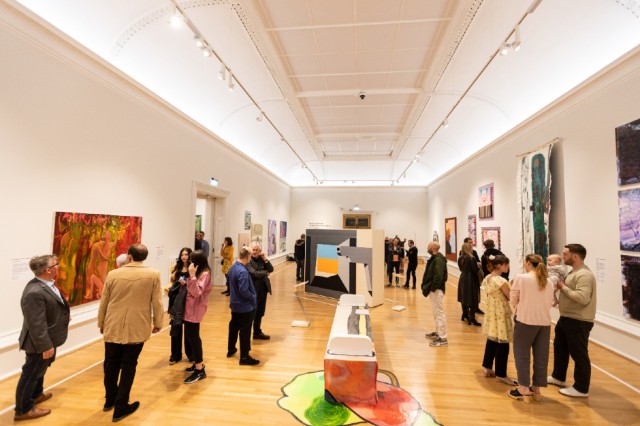Refractive Pool: Contemporary Painting in Liverpool – Reviewed

Taking the temperature of contemporary painting in Liverpool, Refractive Pool features a plethora of styles. Leah Binns investigates the Walker Art Gallery’s current exhibition…
Situated upstairs in Liverpool’s Walker Art Gallery, an institution perhaps best known for its permanent collection of Renaissance, Baroque, pre-Raphaelite, and Impressionist works, Refractive Pool is an exhibition striking in its contemporary edge. Exploring painting in all its forms, it is unified by medium and locale (its artists based in and around Liverpool). Drawing from the well of the city’s artistic talent, curators Brendan Lyons and Josie Jenkins are clear about their ethos. They have opened up a non-hierarchical space that provides a glimpse into up-to-date practice, compelling us to stop looking back into painting’s history (rich as it is), and instead into its future.
The two curators’ works in the exhibition demonstrate the versatility painting offers. Lyons transforms paint into three-dimensional objects such as plastic bags and discarded face masks, to forge a link between the historical act of illusionistic painting, and disposable objects that can befoul our modern world. Suspended in the space between material object and painted subject, Staple Painting (2022), which appears to be staples and scraps of canvas on the white wall, made entirely of paint, is a playful, twenty-first century reinterpretation of trompe l’oeil. Josie Jenkins’ painting, meanwhile, invents imaginary worlds that sit in the liminal outskirts of our own. Familiar objects inhabit otherworldly and loosely-painted landscapes in swampy tones. Toying with scale and uprooting expectations, Jenkins’ work is at once lively and serious, eerie while beautiful.
Elsewhere, Frances Disley’s expressive sculptural work When We Rest (2021), a gallery bench that invites us to sit down and contemplate the space, sits alongside Gareth Kemp’s tightly knit paintings that evoke a whirring mechanical interior, quiet and compact as a car’s engine or the flattened symbolism of a road sign; they possess a glowing urban feel. Millie Toyin Olateju’s abstract Untitled (2021) is a marriage of flowing colour and texture, quite in opposition to Pete Clarke’s collection of shadowy cityscapes, in which dark, jagged scaffolds exist within sweeping scenery, suggesting a city suspended in permanent construction.
Nestled together, four artists weave elements of uncanny storytelling into their paintings. David Jacques’ oversized knot of pipes in Beaumont Sea Phantasmagoric (2021) suggest the tangled narratives of contemporary politics, with a metallic sheen of a churning factory or oil drill. Next to it is a smaller painting with the same theme, but the difference between the two embodies how scale affects subject matter; through its smog, it possesses the tenderness of a Romantic landscape.
James Quin has built a wooden structure to house numerous small paintings. The installation, entitled Solaris Suite (2021) consists of painted stills from Andrei Tarkovsky’s cinematic science fiction masterpiece. The work requires a close look, or for you to crane your neck; some paintings face away from the viewer, or are hidden behind the structure, evading your line of sight much like the unknowable, watery landscape that underpins the plot of the 1972 film. Quin’s dappled brushstrokes lend a mystical element to a genre sometimes accused of being unpoetic. The wooden beams themselves might evoke a sense of confinement in an interplanetary science fiction story, or the constructed nature of those fictions themselves.

Zahra’s beautiful paintings leave a ghostly and macabre impression through their invented narratives, unconventional forms, and ominous lines. In Richard Meaghan’s neighbouring work, I’d Rather Be Whole Than Good, the artist has depicted himself in nature, holding a brush and painting a bird in a tree, referencing the action that the exhibition pivots on. Similarly luminous and lyrical while suggesting an untold story, both artists use neon-like tones alongside warm autumnal hues, providing a vibrant yet woozy edge.
In the next room, hyperrealism sits alongside more abstract painting and ornamental works. The signature intricate style of the Singh Twins will be familiar to many, referencing the importance of ornamental aesthetics and jeweled tones in artistic tradition, entwined with references to contemporary British and American politics; a compelling collision of the timeless and the timely.
Mirrors are prominent in Anna Ketskemety’s works, either as a surface as in Mirror (2021), confronting the viewer with their own reflected image (above), or as a frame, as the viewer’s gaze is met and returned by a painted woman. Such examples recall and play with traditional attempts to reflect the artist or the viewer, or to provide an insight into the unseen world beyond the frame. Luke Skiffington’s Over the Horizon Radar (2021) breaks up an image into planes of colour, like refracted light or a fragmented window, in harmonious hues of pale blue and orange. Sitting opposite each other, these works – in harmony with the exhibition’s Refractive Pool title – summon a sense of confrontation.

From the way Josie Jenkins’ paintings look almost like worlds that humanity has abandoned, to the subdued hues of Skiffington’s style and how Ketskemety’s work is suffused with smoke and melancholy, this room has a quietness to it, acting as a tranquil antidote to the electric colours and energetic scenes that are present elsewhere in the exhibition.
Beyond the gallery, Refractive Pool is an ongoing and developing project that has thus far also spawned a book. Rather than acting as a catalogue or comprehensive list of artists for the show at the Walker, it contextualises and furthers this project, bringing the reader into the studio space as significant setting. In it, artists discuss their relationship with paint and the city, musing on how often the two entwine. Some take the opportunity to construct a narrative; Paul Mellor depicts himself inhabiting a gallery space, referencing his own and other artworks. Nima Javan elicits a visual opulence through colour and shape, while other works, such as that of Bernadette O’Toole’s, framed by wood and simple hovering white blocks, are more stripped back, showing the strength of spare imagery.
What characterises the exhibition – and the wider project to which it belongs – is a sense of fullness; it frames Liverpool in terms of abundance rather than deprivation, shedding new light onto contemporary painting and painters. It provides a summary of why artists and people continually return to the medium. The disparate nature of the pieces provides not a tension but a strength, unifying the exhibition and confirming Liverpool to be an eclectic, lively city through its art scene.
Leah Binns
See Refractive Pool at the Walker Art Gallery, Liverpool, until 8 January 2023 – FREE
Refractive Pool launch images © Robin Clewley





